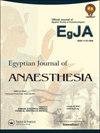Comparison of analgesic efficacy of ultrasound-guided erector spinae block with port site infiltration following laparoscopic cholecystectomy
IF 0.5
Q3 ANESTHESIOLOGY
引用次数: 0
Abstract
ABSTRACT Background One of the foremost common medical reasons for delayed discharge following ambulatory surgery is pain. Erector spinae plane block (ESPB) is a comparatively new technique utilized for intra‑ and post‑operative analgesia. We aimed to compare the analgesic efficacy of ESPB with port site infiltration in laparoscopic cholecystectomy (LC) patients. Methods Forty-four patients 18–60 years old with body mass index (BMI) of 18–35 kg/m2 who were scheduled for laparoscopic cholecystectomy were randomized into two groups (22 patients each) either to obtain an ultrasound‑guided Bilateral ESPB (group A) or port‑site infiltration of local anesthetic (group B) after anesthesia induction. The primary outcome was the total postoperative nalbuphine consumption in the first 24 h. Results The overall amount of rescue analgesia was significantly lower in group A (8.27 ± 1.12 mg for nalbuphine as first-line rescue analgesic and 10 patients needed ketorolac as second line rescue analgesic) than in group B (15.92 ± 2.11 mg for nalbuphine as first-line rescue analgesic and 22 patients needed ketorolac as second-line rescue analgesic) during the first 24 h postoperatively. The time to first analgesic request showed statistically significant difference between the two groups with longer time in group A (p value < 0.001). The numerical rate score at rest and when coughing was significantly lower in group A than group B. Conclusion Erector spinae plane block was superior to port site infiltration regarding decrease in analgesic consumption and prolongation in time of postoperative rescue analgesia in patients undergoing laparoscopic cholecystectomy.腹腔镜胆囊切除术后超声引导竖脊阻滞与端口浸润镇痛效果比较
本文章由计算机程序翻译,如有差异,请以英文原文为准。
求助全文
约1分钟内获得全文
求助全文
来源期刊

Egyptian Journal of Anaesthesia
Medicine-Anesthesiology and Pain Medicine
CiteScore
0.90
自引率
0.00%
发文量
78
 求助内容:
求助内容: 应助结果提醒方式:
应助结果提醒方式:


